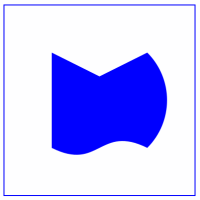
Cairo Basic Sample Overview
The Cairo Basic sample application demonstrates how to use a Cairo image backend with the Tizen SDK.
| Note |
|---|
| The application presented in this overview is not a full Tizen application, since it does not use the Application Framework. The application simply starts and runs. |
The following figure illustrates the main screen of the Cairo Basic.
Figure: Cairo Basic screen

Implementation
First create a basic application. This provides a basic UI application skeleton which already makes available the window object that can contain the Cairo drawing.
- Include the <cairo.h> and <math.h> header files, which are needed for this sample application.
#include <cairo.h> #include <math.h>
- You can define the appdata structure that contains all the pointers to objects to be manipulated.
typedef struct appdata { Evas_Object *win; Evas_Object *img; cairo_surface_t *surface; cairo_t *cairo; unsigned char *pixels; } appdata_s; - To display the Cairo drawing on the screen, create the Elm_window and the Evas_object image.
When creating the Elm_window, you can set the name as your PACKAGE name. It is created when you create this project in the Tizen SDK.
// Window ad->win = elm_win_util_standard_add(PACKAGE, PACKAGE); elm_win_autodel_set(ad->win, EINA_TRUE); if (elm_win_wm_rotation_supported_get(ad->win)) { int rots[4] = { 0, 90, 180, 270 }; elm_win_wm_rotation_available_rotations_set(ad->win, (const int *)(&rots), 4); } evas_object_smart_callback_add(ad->win, "delete,request", win_delete_request_cb, NULL); eext_object_event_callback_add(ad->win, EEXT_CALLBACK_BACK, win_back_cb, ad); evas_object_show(ad->win); // Image ad->img = evas_object_image_filled_add(evas_object_evas_get(ad->win)); evas_object_show(ad->img);
Drawing a Polygon and Rectangle with Cairo
To create the Cairo drawing, you need the window size to set the Cairo surface. You can get the window size with the evas_object_geometry_get() function after the evas_object_show(ad->win) function is called.
To draw Cairo with some specific vector positions, you can use the window size as before.
evas_object_geometry_get(ad->win, NULL, NULL, &ad->width, &ad->height); ad->surface = cairo_image_surface_create(CAIRO_FORMAT_ARGB32, ad->width, ad->height); ad->cairo = cairo_create(ad->surface);
In this example, a Cairo image is drawn on a square screen. You can compare the windows width and height and get the smaller length to set the square side.
void
cairo_drawing(void *data)
{
appdata_s *ad = data;
int d = 0;
if(ad->width < ad->height)
d = ad->width;
else
d = ad->height;
To set the background as white color, set the color as white and paint the Cairo.
// Clear background as white cairo_set_source_rgba(ad->cairo, 1, 1, 1, 1); cairo_paint(ad->cairo);
In the following example, you can draw the polygon and rectangle. You must use the cairo_surface_flush() function. This function call implements any pending drawings for the surface.
cairo_translate(ad->cairo, 0.1 * d, 0.1 * d); cairo_set_line_width(ad->cairo,2); cairo_set_source_rgba(ad->cairo, 0.0, 0.0, 1.0, 1.0); cairo_move_to(ad->cairo, 0.2 * d , 0.2 * d); cairo_line_to(ad->cairo, 0.4 * d, 0.3 * d); cairo_rel_line_to(ad->cairo, 0.2 * d, -0.1 * d); cairo_arc(ad->cairo, 0.4 * d, 0.4 * d, 0.2* d * sqrt(2), -0.25 * M_PI, 0.25 * M_PI); cairo_rel_curve_to(ad->cairo, -0.2* d, -0.1 * d, -0.2* d, 0.1 * d, -0.4 * d, 0); cairo_close_path(ad->cairo); cairo_fill(ad->cairo); cairo_rectangle(ad->cairo, 0, 0, 0.8 * d, 0.8 * d); cairo_stroke(ad->cairo); cairo_surface_flush(ad->surface);
To update the Evas object image on the screen:
// Display the Cairo drawing on screen unsigned char * imageData = cairo_image_surface_get_data(cairo_get_target(ad->cairo)); evas_object_image_data_set(ad->img, imageData); evas_object_image_data_update_add(ad->img, 0, 0, ad->width, ad->height); }
Deleting Cairo
The delete callback is triggered when the Window is destroyed from the main loop.
static void win_delete_request_cb(void *data, Evas_Object *obj, void *event_info)
{
appdata_s *ad = data;
cairo_surface_destroy(ad->surface);
cairo_destroy(ad->cairo);
ui_app_exit();
}
